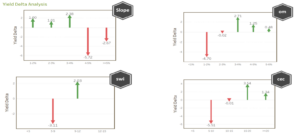Why jumping straight into prescription writing without proper analysis and understanding of outcome can be costly
As you reflect on the growing season, how do you measure success? Is it measuring overall yield improvement over last year or perhaps the year that was most similar in terms of rainfall and average temperature? What about individual fields? When you start to look through yield maps, are you looking to see improvement “on average” for these individual fields? What about each sub-acre within the field?
If you have followed our posts last year, you have read about our thought processes of spatial crop management and how we use foundational agronomic principles we know to be true. We then apply them to sub-field environments to achieve the best possible outcome, regardless of what hand Mother Nature deals us. In the early season, it is all about ground preparation, plant establishment, and the race to canopy. Mid-season, our focus shifts to protecting that crop factory that we have built to maximize our perceived yield potential. But, how do we know what to change for the coming year and what metrics should we be using to guide ourselves down the right path?
How do I know the change I am making is the right one?
When considering adjustments in your management strategy, it is important to first ask yourself if it makes agronomic sense. We have all read articles on marrying agronomics with economics to increase our ROI but take a few moments to think about some core agronomic principles. If you know that the acre with higher elevation and lower organic matter is where performance struggles the most, you need to be asking yourself how you can improve that specific outcome. As an industry, we tend to fall short by simply giving up on those acres. We give up on them because we are led to believe that they will only ever produce “x” bushels, so we manage those acres for a lower yield in the first place – a self-fulfilling prophecy.
Let’s take a blount clay knob, for example. A blount is lower in organic matter (generally <2.5%) and is in a landscape position that is higher in relative elevation. It could be somewhat of a plateau, but will have some slope, making it an acre that is quicker to dry out and will crust leading to difficulties achieving canopy. Knowing this, how would you improve yield in this environment? If you know it is going to be a soil that will be quick to dry out, then you also know it will not be as efficient when it comes to nutrient diffusion. It also will mineralize less organic nitrogen and sulfur throughout the growing season, as compared to a Pewamo, Milford, or Drummer.
To overcome a soil’s natural limitations for crop production, we help growers manage the environment by providing support during times of soil moisture deficit. Increasing nutrient concentrations in the soil and carefully managing early season nitrogen applications can help the crop to achieve canopy quickly and allow the plant to capture and use moisture most effectively, rather than losing it through evaporation.
Now, following these same principles think about those other soils mentioned. A Pewamo, Milford, or Drummer are present in the landscapes that are closer to the water table and tend to be inherently more productive. While this may be the case, it is important to consider other risks that can be associated with this landscape. For instance, if these acres are not tiled well, soil structure would be of concern in most years. The crop may not be planted in ideal conditions, therefore causing sidewall compaction and less extensive root system development. On that same acre, it may lay saturated for extended periods of time and your risk for denitrification can cause major yield losses if nitrogen is not protected.
While you may be thinking to yourself, “yes, I know all these things,” my question to you is this: What are you doing about it?
Looking beyond yield maps
While yield maps offer a visual representation of a year’s outcome, they don’t tell the whole story. We know that understanding hybrid and variety characteristics are critical for best placement, however, marrying those characteristics with an understanding of the attributes that are influencing yield allows for reduced variability and subsequent yield improvement becomes easier.
Using the delta yield examples below, we observe the delta between two soybean varieties of .54 bu/ac on average. While the average yield is similar, we understand performance may vary across environments.

Following along with the two varieties that performed similarly on average, we see clearly how environment influences performance. In this example, we see that Variety A performs well in environments with higher organic matter and lower slope and, most importantly to note, it really struggles in environments with higher slope (>4%) and lower organic matter (<2%). The yield penalty in these unfavorable environments exceeds the upside in favorable environments, which means strategic placement is critically important. Simply looking at the yield data alone would be a costly oversight.

Time spent during the next few months to better understand what attributes are influencing your operation at the sub-field level can provide improvements that you may have never thought possible. The team at Advanced Agrilytics is eager to serve as your agronomic thought partner throughout this process and beyond, focused on providing you with the opportunity to maximize every acre on your operation.
Travis Kimmel
Director of Agronomic Technology